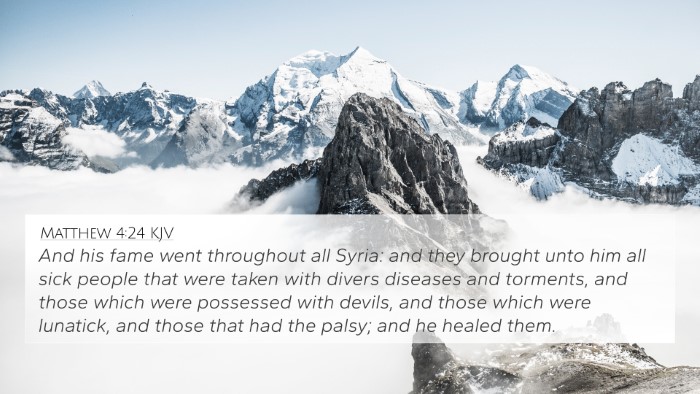Understanding John 6:2
John 6:2 states: "And a great multitude followed him, because they saw his miracles which he did on them that were diseased."
Holy Scripture and Its Context
This verse underscores the significance of Jesus' miraculous works, drawing large crowds due to their profound impact on those who were suffering. Commentators like Matthew Henry and Albert Barnes note that Jesus' miracles were not merely acts of wonder but served to validate His divine mission and authority.
Commentary Insights
- Matthew Henry: Observes that the multitude's desire to follow Jesus stemmed from their physical needs and curiosity. He emphasizes that while their focus may have been on bread and healing, Jesus wanted to lead them toward spiritual nourishment.
- Albert Barnes: Argues that the miracles were signs meant to evoke faith. The large following demonstrates the natural human attraction to miraculous signs and the tendency to seek physical rather than spiritual satisfaction.
- Adam Clarke: Highlights that the crowd's following illustrates the human inclination toward God when witnessing His power. However, he warns that following Jesus for physical miracles is superficial compared to the depth of spiritual engagement He desires.
Thematic Connections
This verse introduces themes of healing, faith, and the duality of human motives when approaching Christ. The context sets the stage for the discourse on the Bread of Life that follows in John 6, linking physical needs with deeper spiritual truths.
Cross-References for John 6:2
- Matthew 4:24: "And his fame went throughout all Syria: and they brought unto him all sick people that were taken with divers diseases and torments..." - showing similar response to Jesus' healing ministry.
- John 2:23: "Now when he was in Jerusalem at the passover, in the feast day, many believed in his name, when they saw the miracles which he did." - indicating the connection between belief and miracles.
- Mark 1:32-34: Describes how the whole city gathered at the door to witness Jesus' healing acts, paralleling the crowd mentioned in John 6:2.
- Luke 6:19: "And the whole multitude sought to touch him: for there went virtue out of him, and healed them all." - reiterating the compelling nature of Jesus' power to heal.
- Acts 10:38: "How God anointed Jesus of Nazareth with the Holy Ghost and with power: who went about doing good, and healing all that were oppressed of the devil..." - affirming Jesus' mission of healing and delivering.
- Isaiah 53:5: "But he was wounded for our transgressions, he was bruised for our iniquities..." - connecting healing with the redemptive work of Christ.
- John 5:16: Illustrates how Jesus’ miracles led to controversy, illustrating the tensions between His works and the authorities of His time.
- John 14:12: "Verily, verily, I say unto you, He that believeth on me, the works that I do shall he do also; and greater works than these shall he do..." - encouraging believers in the power of faith.
- Philippians 3:19: Context of following Christ for the wrong reasons as Paul warns about those whose end is destruction.
Conclusion
John 6:2 serves as an introduction to the broader narrative where physical ailments are addressed with divine compassion, yet it also poses a challenge regarding the motivations of those who seek Christ. It invites believers to reflect on the nature of their faith and the depth of their spiritual hunger.
Exploring Bible Verse Connections
Given the miraculous nature of Jesus’ works, this verse can lead to a comparative Bible verse analysis that deepens understanding through inter-Biblical dialogue, where we identify connections between different parts of Scripture, especially between the Gospels and the messages shared by the Apostles.
Tools for Bible Cross-Referencing
Utilizing tools such as a Bible concordance or a cross-reference Bible study guide can enhance one’s study of Scripture, allowing for quick access to relevant verses that engage with John 6:2. These resources provide comprehensive Bible cross-reference materials that elucidate relationships between various texts.










